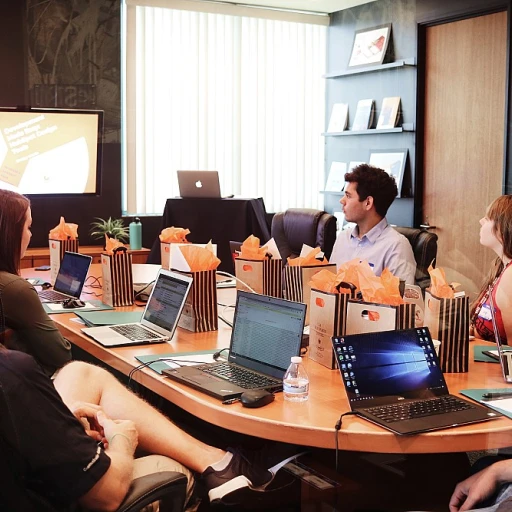Understanding the Role of Ice Breakers in Employee Engagement
The Power of Ice Breakers in Enhancing Employee Engagement
In today's dynamic work environment, fostering effective communication and teamwork is essential. One of the
engaging conversations that can jumpstart this process is incorporating icebreaker questions. These seemingly simple interactions serve a profound purpose. They create an inviting atmosphere that encourages openness among team members.
Consider a typical workday where employees are engrossed in their tasks. Introducing icebreaker questions in meetings can provide the break needed to energize the group. By asking questions such as "What's your favorite movie?" or "What's one fun thing you did last year?", you invite employees to share glimpses of their personal lives. These questions work by breaking down barriers, allowing insights into colleagues' personalities beyond their professional facades.
Not only does this help team members to connect on a personal level, but it also fosters a culture of inclusivity. Whether in-person or during virtual meetings, icebreakers can effectively diminish the rigidity often witnessed in professional settings. They bring out the human element essential for team building, leading to improved morale and productivity.
Ultimately, icebreakers set the stage for better collaboration and understanding within the team. As this section serves to outline, understanding the role of ice breakers is crucial for anyone looking to enhance engagement in their workplace.
Crafting the Perfect Ice Breaker Question
Designing Thoughtful Ice Breaker Questions
Crafting the perfect icebreaker question can transform a routine interaction into an opportunity for genuine connection among team members. To achieve this, it is crucial to consider the language, tone, and intent of the questions you propose.
When designing icebreaker questions, it's advisable to tailor them to the context of the workplace or virtual meetings. What are the team's dynamics? For a creative team, you might opt for more abstract or playful questions, while more analytical teams might enjoy questions that challenge their logical thinking.
To ensure these questions resonate with adults in a professional setting, it helps to keep them both light-hearted and evocative:
- Focus on Interests and Preferences: Ask about favorite things, such as a favorite movie or favorite holiday. This allows team members to share bits of their personal life while keeping the conversation casual.
- Past Experiences and Impressions: Engage with questions about the best year or the most fun day at work. This can prompt storytelling and allow shared experiences, building a sense of camaraderie.
- Future Aspirations and Curious Explorations: Encourage thought-provoking discussions by asking what team members would do if they had all the time in the world, or what they would choose if they could only live one day over and over for the rest of their life.
These types of icebreakers can serve as a conduit for team building and can help individuals feel more comfortable interacting with each other.
Engaging team building activities for adults can further enhance these interactions.
Keep in mind the diverse personalities within the team. Some may prefer humor, where a funny icebreaker question may bring out laughter and ease tension, while others may find more structured or serious questions engaging. Striking the right balance in your question repertoire ensures participation from all team members.
Examples of Effective Ice Breaker Questions for Adults
Discover Engaging Ice Breakers for Adults
Incorporating effective icebreaker questions in workplace settings can considerably enhance team building and make meetings more engaging. By breaking down barriers and encouraging participation, icebreakers can lead to more cohesive and productive teams.
When selecting icebreaker questions, it is essential to consider the interests and cultural backgrounds of team members. Tailoring questions to suit your team can significantly improve their effectiveness. Here are some examples to consider for your next meeting or virtual gathering:
- All-Time Favorite Movie: This question invites team members to share their tastes in entertainment. It opens up avenues for recognizing shared interests and can spark lively debates, all in good fun.
- Best Holiday You've Ever Taken: Encouraging people to recall their best holiday experiences can uplift the mood and reveal fascinating anecdotes, contributing to a positive atmosphere.
- Describe Your Perfect Day Off: This question allows team members to express personal preferences and provides insight into how they enjoy spending their leisure time.
- What is Your Favorite Thing About This Year So Far? It prompts a reflection on positive experiences or achievements, fostering a sense of gratitude and optimism among the team.
- Funny Icebreaker – If You Could Have Dinner with Any Historical Figure, Who Would You Choose? This engaging question combines humor with historical and cultural inquiry, suitable for sparking intellectual conversations.
Virtual teams can particularly benefit from these fun icebreakers, as they bring a personal touch often lacking in remote settings. By implementing thoughtfully chosen icebreaker questions, you can strengthen team dynamics and enhance the work environment over time. However, avoid common pitfalls in their deployment by ensuring inclusivity and relevancy, as discussed in
this analysis of employee engagement pitfalls.
Implementing Ice Breakers in Team Meetings
Seamless Integration of Ice Breakers in Meetings
Implementing ice breakers in team meetings can have a significant impact on employee engagement, helping break down barriers and fostering a more open, communicative environment. When used thoughtfully, they set a lighthearted tone that encourages participation and mutual respect among team members.
To effectively incorporate icebreakers, consider the context of your meeting. Regular team meetings, virtual gatherings, or even larger company-wide sessions can benefit from well-placed questions. Achieving this seamless integration requires planning and creativity to cater the questions to suit the unique dynamics of your team.
- Timing is Key: Introduce your icebreaker at a moment that feels natural and not forced. The beginning of a meeting often works best. This helps to ease everyone into the session.
- Consider the Audience: Tailor icebreaker questions to your team. For some, a question about their favorite movie or holiday can spark creativity and conversation. For others, a lighthearted yet deep question about the best "thing" they've done this year can be more engaging.
- Stay Relevant and Appropriate: Always be mindful of the work environment and cultural sensitivity. Avoid questions that might make any team member uncomfortable or seem overly intrusive.
- Virtual Adaptation: For remote teams, funny icebreaker questions adapted to virtual platforms can be especially effective. Tools and features like breakout rooms and chat functions can help facilitate these interactions.
Importantly, the ultimate goal of employing ice breakers is to enhance team building, not detract from the main purpose of the meeting. Therefore, it is crucial to gauge the mood of the team and adjust the questions accordingly to ensure a positive and constructive atmosphere throughout.
Allowing time for these engaging moments in meetings can turn a mundane workday into a series of productive exchanges. By promoting the use of these tools, you guide your team toward more meaningful engagement and development in the workplace.
Evaluating the Impact of Ice Breakers on Team Dynamics
Assessing the Influence of Ice Breakers on Team Cohesion
Using icebreaker questions to gauge their impact on team dynamics is key to fostering a healthy work environment. By evaluating how these seemingly simple questions play a role in enhancing interpersonal relationships, teams can better understand their strengths and areas for improvement within their virtual or physical space.
These evaluations help assess whether the questions effectively foster connections between team members. Observing interactions during these exercises can offer insights into:
- Improved communication and cooperation
- Increased participation in team-building activities
- Enhanced problem-solving capabilities due to improved trust
Evaluating the impact of icebreakers is not a one-size-fits-all approach. Teams should tailor their assessment methods based on their specific objectives and cultural nuances. For example, a team might take note of the level of enthusiasm displayed during the icebreaker sessions or the spontaneity of conversations that continue after the exercise ends.
Regularly gathering feedback from team members can also provide valuable insights and guide future engagements. Consider asking your team:
- "What was your favorite part about today's icebreaker?"
- "How did the icebreaker help you feel more connected to the rest life team?"
- "What questions work best for our group in building camaraderie?"
Remember, the aim is to create an inclusive environment where every team member feels comfortable contributing, whether it's sharing a personal anecdote about their favorite holiday or engaging in a fun icebreaker during a hectic day.
Continuous reflection on how these exercises impact team interactions will ensure they remain a beneficial tool. This open-minded evaluation helps in keeping the atmosphere lively and ensuring a productive work day throughout the year.
Overcoming Challenges with Ice Breaker Questions
Overcoming Barriers to Effective Ice Breakers
When it comes to integrating icebreaker questions in the workplace, challenges may arise. These can affect their overall impact on team dynamics and employee engagement. Let's look into common barriers and how to overcome them.
Firstly, not all icebreaker questions resonate with every individual in a team. People have diverse personalities, and what might be a fun icebreaker for one person could be uncomfortable for another. To manage this, it's crucial to create a mix of questions that cater to varied preferences and comfort levels. For example, instead of always focusing on personal favorites or "what's your favorite movie," include more neutral or work-related questions, such as "what's one thing you enjoyed doing at work recently?"
Another challenge is the occasional reluctance of team members to participate, especially in a virtual environment. Engaging a virtual team can be trickier due to the lack of in-person interaction. You can help ease this by gradually introducing icebreakers that are simple and require minimal personal disclosure. For example, "If you could have any superpower for a day, what would it be?" is a low-pressure question that might lead to fun discussions.
Timing is also crucial when implementing icebreakers. Introducing them at the wrong moment can lead to awkwardness rather than team building. A good practice is to schedule them at the start of meetings to set a positive tone or during slower times of the year when team dynamics need a boost.
Finally, it's important to evaluate the overall effectiveness of your chosen icebreakers. Regular feedback from the team can help determine which questions work best. This will guide you in crafting more engaging and effective questions that align with the group's dynamic.
Overcoming these challenges involves understanding your team and continuously tailoring your approach to best fit their needs. By doing so, icebreakers can become a tool that genuinely enhances team engagement and makes team meetings more productive and enjoyable.












